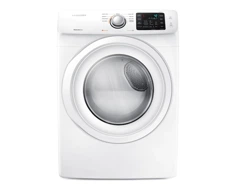Documents: Go to download!
- Owner's manual - (English, French, Spanish)
- INSTALLATION
- OPERATION
- Care and cleaning
- Special laundry tips
- Troubleshooting
- Appendix
- Safety instructions
Table of contents
User manual Gas and Electric Dryer
INSTALLATION
Important to installer
Please read the following instructions carefully before installing the dryer. These instructions should be kept for future reference
 WARNING: Remove the door from all discarded appliances to avoid the danger of a child being trapped and suffocating
WARNING: Remove the door from all discarded appliances to avoid the danger of a child being trapped and suffocating
Basic requirements
Make sure you have everything necessary for the proper installation
- A GROUNDED ELECTRICAL OUTLET is required.
- A POWER CORD electric dryer (except for Canada).
- GAS LINES (if a gas dryer) must meet national and local codes.
- The EXHAUST SYSTEM must be made of rigid metal or flexible stiff-walled metal exhaust ducting.
Grounding
This dryer must be grounded. In the event of a malfunction or breakdown, grounding the product will reduce the risk of electrical shock by providing a path of least resistance for the electrical current.
Gas models
Your dryer has a cord with an equipment-grounding conductor and a grounding plug.
- The plug must be plugged into an appropriate outlet that is properly installed and grounded in accordance with all local codes and ordinances.
- Do not modify the plug provided with your dryer – if it doesn’t fit the outlet, have a proper outlet installed by a qualified electrician.
- Never connect the ground wire to the plastic plumbing lines, gas lines, or hot water pipes.
Electric models
Your dryer has an optional cord with an equipment-grounding conductor and a grounding plug, which is sold separately.
- The plug must be plugged into an appropriate outlet that is properly installed and grounded in accordance with all local codes and ordinances.
- Do not modify the plug provided with your dryer – if it doesn’t fit the outlet, have a proper outlet installed by a qualified electrician.
- If a power cord is not used and the electric dryer is to be permanently wired, the dryer must be connected to a permanently grounded metal wiring system, or an equipment grounding conductor must be run with the circuit conductors and connected to the equipment grounding terminal or lead on the dryer.
Location considerations
The dryer should be located where there is enough space at the front for loading the dryer, and enough space behind for the exhaust system. This dryer is factory-ready for the rear exhaust option. To exhaust out the bottom, right or the left, use the accessory exhaust kit. Instructions are included with the kit. Make sure the room in which the dryer is located has enough fresh air. The dryer must be located where there are no air-flow obstructions. For gas dryers, adequate clearance must be maintained as noted on the data plate to ensure adequate air for combustion and the proper dryer operation.
The dryer must not be installed or stored in an area where it will be exposed to water and/or weather. The dryer area must be kept clear of combustible materials, gasoline, and other flammable vapors and liquids. A dryer produces combustible lint. The area around the dryer should be kept lint-free.
Alcove or closet installations
 WARNING
WARNING
- The dryer must be exhausted to the outside to reduce the risk of fire when installed in an alcove or closet.
- No other fuel-burning appliance should be installed in the same closet as the dryer.
Minimum clearances between the dryer and adjacent walls or other surfaces:
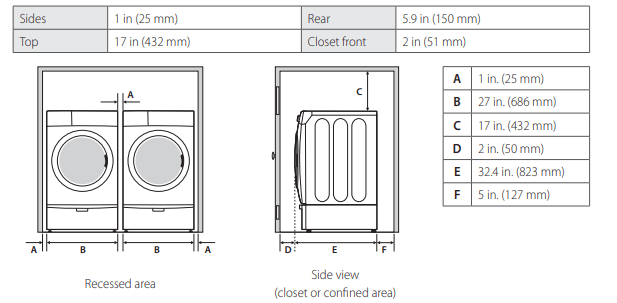
Undercounter installation

Installation with pedestal

Installation with stacked washing machine and dryer
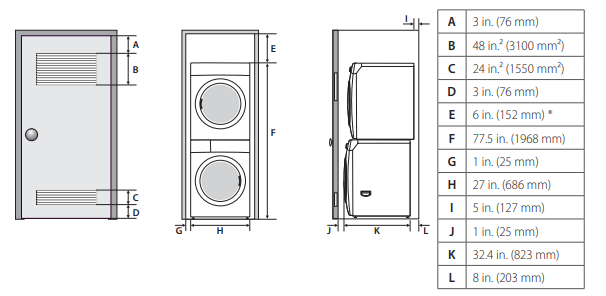
 The front of the closet must have two unobstructed air openings (B, C) for a combined minimum total area of 72 in² (465 cm²) with a minimum clearance of 3 in. (7.6 cm) at the top (A) and bottom (D). External exhaust elbow requires additional space (L).
The front of the closet must have two unobstructed air openings (B, C) for a combined minimum total area of 72 in² (465 cm²) with a minimum clearance of 3 in. (7.6 cm) at the top (A) and bottom (D). External exhaust elbow requires additional space (L).
 Stacking (MODEL NO: SKK-7A)
Stacking (MODEL NO: SKK-7A)
- Samsung’s Washer and Dryer can be stacked to maximize usable space.
- You can purchase an optional stacking kit from your Samsung retailer.
- For details about stacking and compatible models, refer to the user manual included in the stacking kit you purchase.
Ducting requirements

 * Do not use non-metallic flexible ducts.
* Do not use non-metallic flexible ducts.
- Use a 4 inch (10.2 cm) diameter rigid aluminum or rigid galvanized steel duct. • Do not use a smaller duct
- Ducts larger than 4 inches (10.2 cm) in diameter can result in increased accumulation of lint.
- Lint should be removed regularly.
- If a flexible metal duct must be used, use the type with a stiff sheet metal wall. Do not use a flexible duct with a thin foil wall. A serious blockage can result if the flexible metal duct is bent too sharply.
- Never install any type of flexible duct in walls, ceilings, or other concealed spaces.
- Keep the exhaust duct as straight and short as possible.
- Secure joints with duct tape. Do not use screws.
- Plastic flexible ducts can kink, sag, be punctured, reduce airflow, extend drying times, and affect the dryer operation.
- Exhaust systems longer than recommended can extend drying times, affect machine operations, and collect lint.
- The exhaust duct should end with an exhaust hood with a swing-out damper to prevent back drafts and entry of wildlife. Never use an exhaust hood with a magnetic damper.
- The hood should have at least 12 inches (30.5 cm) of clearance between the bottom of the hood and the ground or other obstruction. The hood opening should point down.
- Never install a screen over the exhaust outlet.
- To avoid lint buildup, do not exhaust the dryer directly into a window well. Do not exhaust under a house or porch.
- If the exhaust duct must run through an unheated area, the duct should be insulated and slope slightly down towards the exhaust hood to reduce condensation and lint buildup.
- Inspect and clean the interior of the exhaust system at least once a year. Unplug the power cord before cleaning.
- Check frequently to make sure the exhaust hood damper opens and closes freely.
- Check once per month, and clean at least once per year. Note: If your clothes are not getting dry, then check the duct for obstructions.
- Do not exhaust the dryer into a wall, ceiling, crawl space, or concealed space of a building, gas vent, or any other common duct or chimney. This could create a fire hazard from the lint expelled by the dryer.
If the new dryer is installed into an existing exhaust system you must make sure:
- The exhaust system meets all local, state, and national codes.
- That a flexible plastic duct is not used
- To inspect and clean all lint buildup from inside the existing duct.
- The duct is not dented or crushed.
- The exhaust hood damper opens and closes freely.
- The static pressure in any exhaust system must not exceed 0.83 inches of water column, or be less than 0.
- This can be measured with the dryer running with a manometer at the point where the exhaust duct connects to the dryer. A no-heat setting should be used. The dryer tumbler should be empty and the lint filter clean.
Exhausting
The dryer shall not be exhausted into a chimney, a wall, a ceiling, an attic, a crawl space, or a concealed space of a building.
Exhausting the dryer to the outside will prevent large amounts of lint and moisture from being blown into the room.

- All dryers must be exhausted to the outside.
- Do not assemble the duct with screws or other fastening means that extend into the duct and catch lint.
- The exhaust duct should be 4 inches (102 mm) in diameter.
- The total length of flexible metal duct shall not exceed 2.4 m (7.8 ft.).
In the United States:
Use only those foil-type flexible ducts, if any, specifically identified for use with the appliance by the manufacturer and that comply with the Outline for Clothes Dryer Transition Ducts, Subject 2158A.
In Canada:
Use only those foil-type flexible ducts, if any, specifically identified for use with the appliance by the manufacturer.
Outside the U.S. and Canada:
Refer to the local codes
 WARNING
WARNING
- The dryer must be exhausted to the outside to reduce the risk of fire when installed in an alcove or closet.
- NEVER USE A PLASTIC OR NON-METAL FLEXIBLE DUCT. If your existing ductwork is plastic, non-metal, or combustible, replace it with metal. Use only a metal exhaust duct that is non-flammable to ensure containment of the exhaust air, heat, and lint.
Dryer exhaust tips
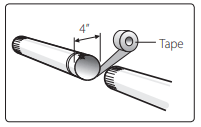
 WARNING: A plastic or non-metal flexible duct presents a potential fire hazard.
WARNING: A plastic or non-metal flexible duct presents a potential fire hazard.
- Make sure your dryer is installed properly so it exhausts air easily.
- Use a 4” diameter rigid metal duct. Tape all joints, including at the dryer. Never use lint-trapping screws.
- Keep ducts as straight as possible.
- Clean all old ducts before installing your new dryer.
- Be sure the vent flap opens and closes freely.
- Inspect and clean the exhaust system annually
Don’t let a poor exhaust system slow the drying process by:
- Restricting your dryer with a poor exhaust system.
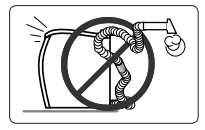
- Using a plastic, thin foil, or non-metal flexible duct.
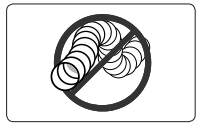
- Unnecessarily using long ducts that have many elbows.
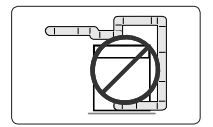
- Allowing dented or clogged ducts and vent.

Gas requirements
THE INSTALLATION MUST CONFORM WITH LOCAL CODES, OR IN THE ABSENCE OF LOCAL CODES, WITH THE NATIONAL FUEL GAS CODE ANSI/Z223.1, LATEST REVISION (FOR THE UNITED STATES), OR WITH THE CAN/CGA-B149 INSTALLATION CODES (FOR CANADA).
- Use only natural or LP (liquid propane) gases.
- This dryer designed for use with natural gas. If you plan to use your dryer with LP gas (liquid propane), the conversion must be done by a qualified service technician in order to achieve safe and proper performance. (LNG models only)
- A 1/2 inch (1.27 cm) gas supply line is recommended and must be reduced to connect to the 3/8 inch (1 cm) gas line on your dryer. The National Fuel Gas Code requires that an accessible, approved manual gas shut-off valve be installed within 6 inches of your dryer.
- Gas dryers installed in residential garages must be raised 18 inches (46 cm) above the floor.
- Additionally, a 1/8 inch (0.3 cm) N.P.T. (National Pipe Thread) plugged tapping, accessible for test gauge connection, must be installed immediately upstream of your dryer’s gas supply connection.
- Your dryer must be disconnected from the gas supply pipe system during any pressure testing of the system.
- DO NOT reuse old flexible metal gas lines. Flexible gas lines must be design certified by the American Gas Association (CGA in Canada).

- Any pipe joint compound used must be resistant to the action of any liquefied petroleum gas.
- As a courtesy, most local gas utilities will inspect a gas appliance installation.
GAS IGNITION - Your dryer uses an automatic ignition system to ignite the burner. There is no constant burning pilot.
Commonwealth of massachusetts installation instructions
Your dryer must be installed by a licensed plumber or gas fitter. A “T” handle manual gas valve must be installed in the gas supply line to your dryer. If a flexible gas connector is used to install your dryer, the connector may not be longer than 3 feet (36 inches).
 WARNING
WARNING
- Gas leaks may occur in your system, creating a dangerous situation.
- Gas leaks may not be detected by smell alone.
- Gas suppliers recommend that you purchase and install a UL-approved gas detector.
- Install and use it in accordance with the manufacturer’s instructions.
Exhaust ducting guide
Ducting
- Make sure the dryer is installed properly so the air exhausts freely.
- Use 4-inch rigid metal ducts. Tape all joints including the dryer connection. Never use lint-trapping screws.
- To facilitate the exhaust, keep the ducts as straight as possible.
Cleaning
Clean all old ducts before installing the dryer, and make sure the vent flap opens and closes freely. We recommend that you clean the exhaust system annually or on a regular basis.
 WARNING
WARNING
- To prevent fire, do not use plastic, thin-foil, or non-metal flexible ducts of any kind.
- Do not use a poor exhaust system because it slows down the dryer’s performance.
- Do not use excessively long ducts that have multiple elbows.
- Do not use crushed or clogged venting or ducts.
Electrical requirements
The wiring diagram is located on the plate below the control panel.
 WARNING
WARNING
- The improper connection of the equipment grounding conductor can result in a risk of electric shock. Check with a qualified electrician or serviceman if you are in doubt as to whether your dryer is properly grounded. Do not modify the plug provided with your dryer - if it doesn’t fit the outlet, have a proper outlet installed by a qualified electrician.
- To prevent unnecessary risk of fire, electrical shock, or personal injury, all wiring and grounding must be done in accordance with local codes, or in the absence of local codes, with the National Electrical Code, ANSI/NFPA No. 70-Latest Revision (for the U.S.) or the Canadian Electrical Code CSA C22.1 - Latest Revisions and local codes and ordinances. It is your responsibility to provide adequate electrical services for your dryer.
- All gas installations must be done in accordance with the national Fuel Code ANSI/Z2231 - Latest Revision (for the U.S.) or CAN/CGA - B149 Installation Codes - Latest Revision (for Canada) and local codes and ordinances.
Electrical connections
- Before operating or testing, follow all grounding instructions in the “Grounding” section on page 9.
- An individual branch (or separate) circuit serving only your dryer is recommended. DO NOT USE AN EXTENSION CORD.
Gas models – U.S. and Canada
- A 120 volt, 60 Hz AC approved electrical service, with a 15-ampere fuse or circuit breaker is required.
Electric models – U.S. only
- Most U.S. dryers require a 120/240 volt, 60 Hz AC approved electrical service. Some require 120/208 volt, 60 Hz approved electrical service. The electric service requirements can be found on the data label located behind the door. A 30-ampere fuse or circuit breaker on both sides of the line is required.
- If a power cord is used, the cord should be plugged into a 30-ampere receptacle.
- The power cord is NOT provided with U.S. electric model dryers.
 WARNING - RISK OF ELECTRIC SHOCK
WARNING - RISK OF ELECTRIC SHOCK
When local codes allow, the electrical supply of the dryer may be connected by means of a new power supply cord kit, marked for use with a dryer, that is U.L. listed and rated at a minimum of120/240 volts, 30-ampere with three No. 10 copper wire conductors terminated with closed loop terminals, open-end spade lugs with turned up ends, or with tinned leads.
- Do not reuse a power supply cord from an old dryer. The power cord electric supply wiring must be retained at the dryer cabinet with a suitable UL-listed strain relief.
- Grounding through the neutral conductor is prohibited for (1) new branch-circuit installations, (2) mobile homes, (3) recreational vehicles, and (4) areas where local codes prohibit grounding through the neutral conductor. (Use a 4-prong plug for 4 wire receptacles, NEMA type 14-30R.)
Electric models – Canada Only
- A 120/240 volt, 60 Hz AC approved electrical service fused through a 30-ampere fuse or circuit breaker on both sides of the line is required.
- All Canadian models are shipped with the power cord attached. The power cord should be plugged into a 30-ampere receptacle.
 In Canada, you may not convert a dryer to 208 volts.
In Canada, you may not convert a dryer to 208 volts.
3-WIRE system connections
- Loosen or remove the center terminal block screw.
- Connect the neutral wire (white or center wire) of the power cord to the center, silver-colored terminal screw of the terminal block. Tighten the screw.
- Connect the other wires to the outer terminal block screws. Tighten the screws.
- Tighten the strain relief screws.
- Insert the tab of the terminal block cover into your dryer’s rear panel slot.
- Secure the cover with a hold-down screw.

 If converting from a 4-wire electrical system to a 3-wire, the ground strap must be reconnected to the terminal block support to ground the dryer frame to the neutral conductor.
If converting from a 4-wire electrical system to a 3-wire, the ground strap must be reconnected to the terminal block support to ground the dryer frame to the neutral conductor.
4-WIRE system connections
- Remove the center terminal block screw.
- Connect the ground wire (green or unwrapped) of the power cord to the external ground conductor screw.
- Connect the neutral wire (white or center wire) of the power cord and the appliance ground wire (white or green/yellow stripes) under the central screw of the terminal block.
- Connect the other wires to the outer terminal block screws. Tighten the screws.
- Tighten the strain relief screws.
- Insert the tab of the terminal block cover into your dryer’s rear panel slot.
- Secure the cover with a hold-down screw.

- With a level, check your dryer and make the necessary adjustments to the leveling legs.
- At this time, make sure all gas connections (on gas models), exhaust and electrical connections are complete. Plug in your dryer, and check its operation by using the checklist below.
- (GAS MODELS ONLY) The burner may not ignite initially due to air in the gas line. Allowing your dryer to operate on a heat setting will purge the line. If the gas does not ignite within 5 minutes, turn your dryer off and wait 5 minutes. Be sure the gas supply to your dryer has been turned on. In order to confirm the gas ignition, check the exhaust for heat.
Connecting the inlet hose (Steam model only)
The dryer must be connected to the cold water faucet using the new inlet hoses. Do not use old hoses.
1. Turn the cold water faucet off.
2. Attach the brass female end of the Y connector (A) to the cold water faucet.
3. Attach the straight end of long hose (B) to the Y connector.
4. Using pliers, tighten the coupling with an additional two-thirds turn.
 If the Y connector cannot be attached directly to the cold water faucet, the short hose must be used. (If space permits, please skip steps 5 to 8, and go directly to step 9.)
If the Y connector cannot be attached directly to the cold water faucet, the short hose must be used. (If space permits, please skip steps 5 to 8, and go directly to step 9.)
5. Attach the short inlet hose (C) to the cold water faucet. Screw on the coupling by hand until it is seated on the faucet.
6. Using the pliers, tighten the coupling with an additional two-thirds turn.
7. Attach the Y connector (A) to the brass male end of the small hose. Screw on the coupling by hand until it is seated on the connector.
8. Using the pliers, tighten the coupling with an additional two-thirds turn.
9. Attach the angled end of long hoses to the fill valve at the bottom of the dryer rear frame. Screw on the coupling by hand until it is seated on the fill valve connector.
10. Using pliers, tighten the coupling with an additional two-thirds turn.
11. Attach the washer hose (D) to the other side of the Y connector (A). Screw on the hose coupling until it is tight. Using pliers, tighten the coupling with an additional two thirds turn.
12. Check that the water faucets are on.
13. Check for leaks around the Y connector, faucets and hoses.
 When you tighten the coupling with pliers, do not overtighten. This may damage the coupling.
When you tighten the coupling with pliers, do not overtighten. This may damage the coupling.
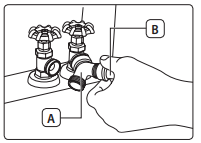

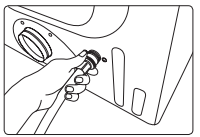
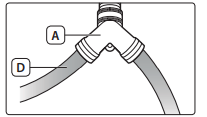
Replacement parts and accessories
If your dryer requires replacement parts or accessories, contact the dealer where you purchased your dryer or the SAMSUNG customer care center at 1-800-SAMSUNG (726-7864).
Installation
For the proper installation, we recommend that you hire a qualified installer.
1. Move your dryer to an appropriate location for the installation. Consider installing the dryer and washer side-by-side, to allow access to the gas, electrical, and exhaust connections. Place two of the carton cushion-tops on the floor. Tip your dryer on its side so it lies across both cushion-tops.
2. Set your dryer back in an upright position.
3. To ensure that the dryer provides the optimal drying performance, it must be level. To minimize vibrations, noise, and unwanted movement, the floor must be a perfectly level, solid surface. To set the dryer to the same height as the washer, fully retract the leveling feet (A) by turning them counterclockwise, then loosen the legs by turning them clockwise.
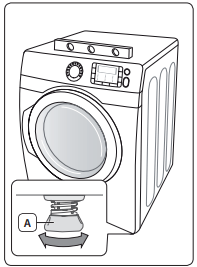
4. Review the “Exhausting” section on page 13 before installing the exhaust system. Install the ductwork from your dryer to the exhaust hood. The crimped end of the duct sections must point away from your dryer.
- DO NOT use sheet metal screws when assembling the ducting. These joints should be taped.
- Never use plastic flexible exhaust material.
- Tip for tight installations: install a section of the exhaust system onto your dryer before putting it in place.
- Use duct tape to secure this section to your dryer, but do not cover the ventilation slots at the back of the unit in dryer cabinet.
5. Review the “Electrical requirements” section . BEFORE OPERATING OR TESTING, follow the grounding instructions in the “Grounding” section
6. Review the “Gas requirements” section . Remove the pipe thread protective cap. Apply a pipe joint compound or about 1½ wraps of Teflon tape over all threaded connections.
Door reversal
Type 1
- Unplug the power cord.
- Remove two door hinge screws.
- Lift the door and remove it.
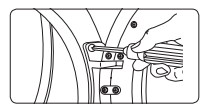
- Remove two screws from the frame front.

- Remove the two screws from the opposite side of the door hinge
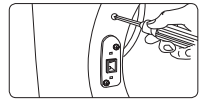
- Remove the two screws from the holder lever.
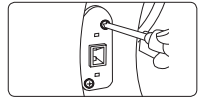
- Reassemble the two screws on the inside holes.

- Remove a screw from the door hinge.

- Reassemble the screw in the other hole.

- Place the door on the other side and reattach it to the dryer.

- Reattach the holder lever.
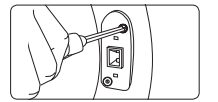
- Reattach the screws in the remaining holes.
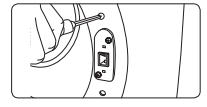
Type 2
- Unplug the power cord.
- Remove two door hinge screws.
- Lift the door and remove it.

- Remove two screws from the frame front.
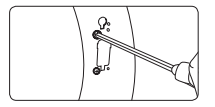
- Remove the two screws from the opposite side of the door hinge.
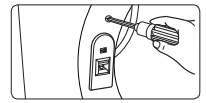
- While holding down the upper hook (A) using the flat-head screwdriver in your right hand, pull out the upper area of the holder lever with your left hand to remove.
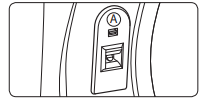

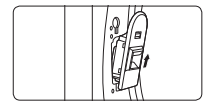
- Reassemble the two screws on the inside holes.

- Remove a screw from the door hinge.

- Reassemble the screw in the other hole.

- Place the door on the other side and reattach it to the dryer.
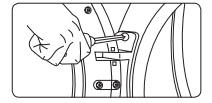
- Fit the lower area of the holder lever in the frame-front hole in the arrow direction, and push in the holder lever to the end while holding down the hook (A).
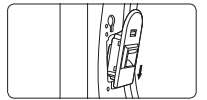

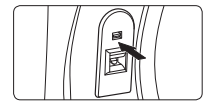
- Reattach the screws in the remaining holes.

- When the holder lever is attached properly, it is supposed to be flexible in all four directions.
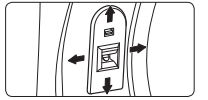
Final installation checklist
- The dryer is plugged into an electrical outlet and is properly grounded.
- The exhaust ductwork is hooked up and the joints are taped.
- A plastic flexible duct is NOT used.
- Use rigid or stiff-walled flexible metal vent material.
- The dryer is level and is sitting firmly on the floor.
- Gas models – the gas is turned on with no gas leaks.
- Start your dryer to confirm that it runs, heats, and shuts off.
OPERATION
Operating instructions, tips
 To reduce the risk of fire, electric shock, or injury to persons,read the IMPORTANT SAFETY INSTRUCTIONS before operating this appliance.
To reduce the risk of fire, electric shock, or injury to persons,read the IMPORTANT SAFETY INSTRUCTIONS before operating this appliance.
Overview of the control panel
 The courses and functions differ depending on the model. Please check your model before proceeding
The courses and functions differ depending on the model. Please check your model before proceeding
DV42H5400*
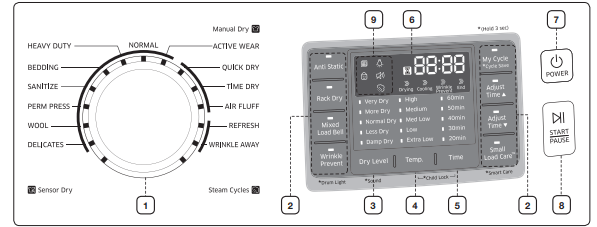
DV42H5200*

DV42H5000*
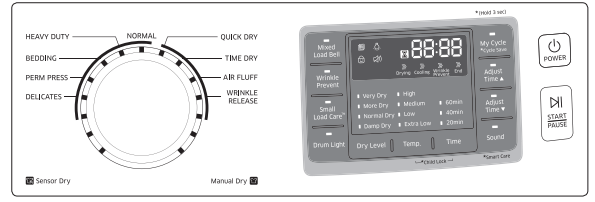
Load the dryer properly
- Place only one washload in your dryer at a time.
- Mixed loads of heavy and lightweight fabrics will dry differently, which may result in lightweight fabrics being dry while heavy fabrics remain damp at the end of a drying cycle
- Add one or more similar items to your dryer when only one or two articles of clothing need drying. This improves the tumbling action and drying efficiency.
- Overloading restricts tumbling action, resulting in uneven drying as well as excessive wrinkling of some fabrics.
 If you insert laundry into your dryer while it is extremely tangled immediately after your washer has finished a wash or spin cycle, it may degrade the drying efficiency or cause the door to open. We recommend that you untangle your laundry appropriately before inserting it.
If you insert laundry into your dryer while it is extremely tangled immediately after your washer has finished a wash or spin cycle, it may degrade the drying efficiency or cause the door to open. We recommend that you untangle your laundry appropriately before inserting it.
Getting started
- Load your dryer loosely (DO NOT overload).
- Close the door.
- Select the appropriate cycle and options for the load. (For detail, refer to the “Cycle overview” on next page.)
- Press the Start/Pause button.
- The dryer indicator light will illuminate.
- The estimated cycle time will appear in the display. The time may fluctuate as humidity levels fluctuate in the dryer.

- When the cycle is complete, “End” will appear in the display.
- Pressing Power cancels the cycle and stops your dryer.
- The Drying, Cooling, and Wrinkle Prevent indicator lights will illuminate during those portions of the cycle.
Cycle overview
Predefined
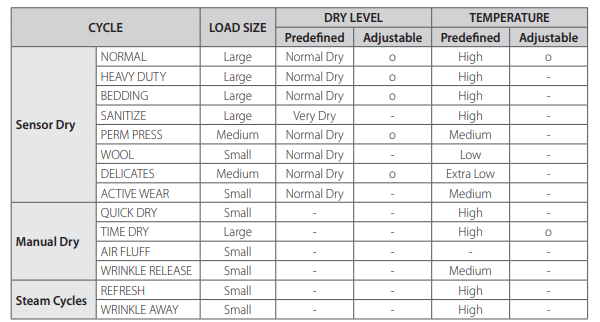
 Load size recommendations
Load size recommendations
For best results, follow the load size recommendations for each drying cycle.

Options

Child Lock
- Prevents children from playing with your dryer.
Setting/Releasing
- To turn Child Lock on or off, press both the Temp. and Time buttons simultaneously for 3 seconds.
Child Lock Details
- You can turn Child Lock on while your dryer is running.
- Once you set the Child Lock function, no button, except for the Power button, will respond until you turn off the Child Lock function.
- The “Child Lock ” indicator will be lit
Drum Light
- Lights the dryer drum while the dryer is running.
Turning On and Off
- To turn on or turn off the Drum Light, press and hold the Wrinkle Prevent (DV42H5400*) / Small Load Care™ (DV42H5200*) button for 3 seconds; press the Drum Light (DV42H5000*) button.
Sound Off
- Use this function to mute the button and operating sounds
Setting and Releasing
- To turn the Sound Off function on or off, press and hold the Dry Level button for 3 seconds (DV42H5400*); press the Sound button (DV42H5200*, DV42H5000*).
Sound Off Details:
- You can set Sound Off while your dryer is running.
- Once you have activated Sound Off, the button and operating sounds are muted until you deactivate it.
- The “Sound Off ” indicator will be lit.
My Cycle
Load
- Press the My Cycle button for less than 3 seconds to activate My Cycle mode where all course settings and selected options are loaded
- The My Cycle indicator turns on when the mode is active
- If you have not configured any My Cycle settings, the default course settings are loaded.
Save
You can add and save preferred options to My Cycle.
- Turn the course dial to select a course.
- Set necessary options for the selected course. For details on each course and options
- Press and hold the My Cycle button for more than 3 seconds to save the course options. The My Cycle indicator blinks while the options are being saved.
Smart Care
This function enables you to check the status of the dryer using a smartphone.
- Press and hold the Small Load Care™ (DV42H5400*) or Sound (DV42H5200*, DV42H5000*) button for 3 seconds when an error occurs or if you haven’t pressed any buttons on the dryer after you turned the power on.
- When the Smart Care function is activated, the LED on the window display rotates for 2 or 3 seconds and then the error code will appear in the display panel.
- Run the Smart Care app on your smart phone
- If the smart phone’s camera is focused on the display panel of the dryer, the panel and error message is automatically recognized and the error type and countermeasures are displayed on the smart phone.
- If the smartphone fails to recognize the error code more than twice, please enter the error code displayed on the display panel of the dryer manually into the Smart Care app.
Downloading the Smart Care app
- Download the Samsung Laundry App into your mobile phone from the Android market or Apple App store. (Search word : Samsung Smart Washer/Dryer)
Precautions when using Smart Care
- If light from a light bulb, fluorescent bulb, or lamp is reflected on the display panel of the washing machine, the smartphone may not be able to recognize the panel or error message easily.
- If you hold the smartphone at too large an angle relative to the front of the display panel, it may not be able to recognize the error code. For best results, hold the smartphone so that the front of the panel and the smartphone are parallel or nearly parallel.
Care and cleaning
Control panel
- Clean with a soft, damp cloth. Do not use abrasive substances.
- Do not spray cleaners directly on the panel.
- The control panel finish may be damaged by some laundry pre-treatment soil and stain remover products.
- Apply such products away from your dryer and wipe up any spills or overspray immediately
Tumbler
- Remove any stains caused by crayon, ink, or fabric dye (from new items such as towels or jeans) with an allpurpose cleaner.
- Tumble old towels or rags to remove any remaining stain or cleaning substance.
- Once these steps are followed, stains may still be visible, but should not transfer to subsequent loads.
Stainless steel tumbler
- To clean the stainless steel tumbler, use a damp cloth with a mild, non-abrasive cleaner suitable for stainless steel surfaces.
- Remove the cleaner residue and dry with a clean cloth.
Dryer exterior
- Clean with a soft, damp cloth. Do not use abrasive substances.
- Protect the surface from sharp objects.
- Do not place any heavy or sharp objects or a detergent box on the dryer. Keep them on the purchased pedestal or in a separate storage box. This may scratch or damage the top cover of the dryer.
- Since the entire dryer has a high-gloss finish, the surface can be scratched or damaged.
- Avoid scratching or damaging the surface when using the dryer.
Dryer exhaust system
- Should be inspected and cleaned yearly to maintain optimum performance.
- The outside exhaust hood should be cleaned more frequently to ensure proper operation.
Clean the lint filter
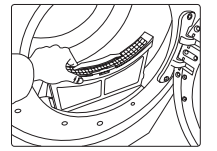
- After each load.
- To shorten drying time.
- To operate more energy efficiently.
 Do not operate your dryer without the lint filter in place.
Do not operate your dryer without the lint filter in place.
Special laundry tips
Special laundry tips
Please follow the care label or manufacturer’s instructions for drying special items. If care label instructions are not available, use the following information as a guide.
Bedspreads & Comforters
- Follow the care label instructions or dry on the BEDDING cycle.
- Make sure the item is thoroughly dry before using or storing.
- May require repositioning to ensure even drying.
Blankets
- Use NORMAL cycle and dry only one blanket at a time for best tumbling action.
- Make sure the item is thoroughly dry before using or storing.
Curtains & Draperies
- Use the PERM PRESS cycle and Medium temperature to help minimize wrinkling.
- Dry these in small loads for best results and remove as soon as possible.
Cloth Diapers
- Use the NORMAL cycle and the High temperature settings for soft, fluffy diapers.
Down–filled Items (jackets, sleeping bags, comforters, etc.)
- Use the NORMAL cycle and the Medium temperature setting.
- Adding a couple of dry towels shortens drying time and absorbs moisture
Foam Rubber (rug backs, stuffed toys, shoulder pads, etc.)
- DO NOT dry on a heat setting. Use the AIR FLUFF cycle (no heat).
- WARNING – Drying a rubber item with heat may damage it or be a fire hazard.
Pillows
- Use the NORMAL cycle.
- Add a couple of dry towels and a pair of clean sneakers to help the tumbling action and to fluff the item.
- DO NOT dry kapok or foam pillows in dryer. Use the AIR FLUFF cycle.
Plastics (shower curtains, outdoor furniture covers, etc.)
- Use the AIR FLUFF cycle or the TIME DRY cycle and the Low or Extra Low temperature settings depending on the care label instructions.
THINGS TO AVOID PUTTING IN THE DRYER:
- Fiberglass items (curtains, draperies, etc.).
- Woolens, unless recommended on the label.
- Vegetable oil- or cooking oil-soaked, or gasoline-soaked items.
Troubleshooting
Check these points if your dryer…
Doesn’t run.
- Make sure the door is latched shut
- Be sure the power cord is plugged into a live electrical outlet.
- Check the home’s circuit breaker and fuses
- Press the Start/Pause button again if the door is opened during the cycle.
Doesn’t heat.
- Check the home’s circuit breaker and fuses.
- Select a heat setting other than Air Fluff.
- On a gas dryer, check that the gas supply is on
- Clean the lint filter and exhaust duct.
- Dryer may have moved into the cool-down phase of the cycle.
Doesn’t dry.
- Check all of the above, plus...
- Be sure the exhaust hood outside the home can open and close freely.
- Check exhaust system for lint buildup. Ducting should be inspected and cleaned annually.
- Use a 4” rigid metal exhaust duct.
- Do not overload. 1 wash load = 1 dryer load
- Sort heavy items from lightweight items.
- Large, bulky items like blankets or comforters may require repositioning to ensure even drying.
- Check that the dryer is draining properly to extract adequate water from the load.
- Load may be too small to tumble properly. Add a few towels.
Is noisy.
- Check the load for objects such as coins, loose buttons, nails, etc. Remove promptly.
- It is normal to hear the dryer gas valve or heating element cycle on and off during the drying cycle.
- Be sure the dryer is leveled properly as outlined in the installation instruction.
- It is normal for the dryer to hum due to the high velocity of air moving through the dryer drum and exhaust system.
Dries unevenly.
- Seams, pockets, and other similarly heavy areas may not be completely dry when the rest of the load has reached the selected dryness level. This is normal. Select the Very Dry setting if desired.
- If one heavy item is dried with a lightweight load, such as one towel with sheets, it is possible that the heavy item will not be completely dry when the rest of the load has reached the selected dryness level. Sort heavy items from lightweight items for best drying results.
Has an odor.
- Household odors from painting, varnishing, strong cleaners, etc. may enter the dryer with the surrounding room air. This is normal as the dryer draws the air from the room, heats it, pulls it through the tumbler, and exhausts it outside.
- When these odors linger in the air, ventilate the room completely before using the dryer.
Shuts off before load is dry
- Dryer load is too small. Add more items or a few towels and restart the cycle.
- Dryer load is too large. Remove some items and restart the dryer.
Lint on clothes
- Make sure the lint filter is cleaned before every load. With some loads that produce high amounts of lint, it may be necessary to clean the filter during the cycle.
- Some fabrics are lint producers (for example, a fuzzy white cotton towel) and they should be dried separately from clothes that are lint trappers (for example, a pair of lack linen pants)
- Divide larger loads into smaller loads for drying.
- Check pockets thoroughly before washing and drying clothes.
Garments still wrinkled after Wrinkle-Care
- Small loads of 1 to 4 items work best.
- Load fewer garments.Load similar-type garments.
Odors remain in clothing after Refresh.
- Fabrics containing strong odors should be washed in a normal cycle.
Water drips from nozzle when SteamCare starts
- This is steam condensation. The dripping water will stop after a short time
Sprayed water is not visible during SteamCare
- Sprayed water is difficult to see when the door is closed.
Extended time
- Verify correct loading (clothes) / cycle selection
Information codes
Information codes may be displayed to help you better understand what is occurring with your Dryer.
tE
- The thermistor resistance is very low or high.
- Clean the screen or vent.
- If the problem continues, call for service.
HE
- Invalid heating Temp when the dryer is running
- Call for service
dE
- Running the dryer with door open.
- Clean the door and then restart.
- If the problem continues, call for service.
bE2
- Invalid state of key.
- Make sure a button is NOT being pressed continuously. Try restarting the cycle.
- If the problem continue, call for service
FE
- Invalid power source frequency.
- Try restarting the cycle.
- If the problem continues, call for service.
9E1
- Electronic Control Problem (Over Voltage Error.)
- Call for service
AE
- Electronic Control Problem (Communication Error.)
- Call for service.
EEE
- Invalid state of Eeprom communication.
- Call for service.
dF
- Invalid door.
- Call for service.
Appendix
Fabric care chart
The following symbols provide garment care direction. The Clothing care labels include symbols for washing, bleaching, drying, and ironing, or dry cleaning when necessary. The use of symbols ensures consistency among garment manufacturers of domestic and imported items. Follow care label directions to maximize garment life and reduce laundering problems.

** The dot symbols represent appropriate wash water temperatures for various items. The temperature range for Hot is 105 – 125 °F (41 – 52 °C), for Warm 85 – 105 °F (29 – 41 °C) and for Cold 60 – 85 °F (16 – 29 °C). (Wash water temperature must be a minimum of 60 °F (16 °C) for detergent activation and effective cleaning.)
Protecting the environment
This appliance is manufactured from recyclable materials. If you decide to dispose of this appliance, please observe local waste disposal regulations. Cut off the power cord so that the appliance cannot be connected to a power source. Remove the door so that animals and small children cannot get trapped inside the appliance.
Declaration of conformity
This appliance complies with UL2158.
Specifications
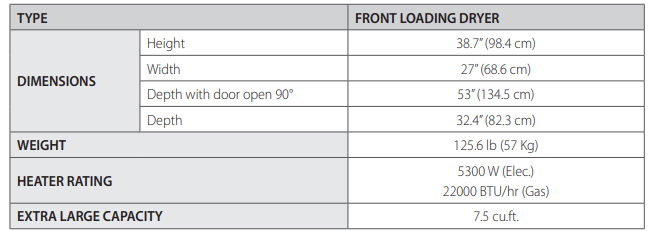
Safety instructions
Congratulations on your new Samsung Dryer. This manual contains important information on the installation, use, and care of your appliance. Please take the time to read this manual to take full advantage of your dryer’s many benefits and features.
What you need to know about safety instructions
Please read this manual thoroughly to ensure that you know how to operate the extensive features and functions of your new appliance safely and efficiently. Retain the manual in a safe place near the appliance for future reference. Use this appliance only for its intended purpose as described in this instruction manual. The Warnings and Important Safety Instructions in this manual do not cover all possible conditions and situations that may occur. It is your responsibility to use common sense, caution, and care when installing, maintaining, or operating your dryer.
Always contact your manufacturer about problems or conditions you do not understand.
Important safety symbols and precautions

These warning signs are here to prevent injury to you and others.
Please follow them explicitly.
After reading this section, keep it in a safe place for future reference.
 WARNING - GAS APPLIANCES
WARNING - GAS APPLIANCES
- State of California Proposition 65 Warning (US only) This product contains chemicals known to the State of California to cause cancer and birth defects or other reproductive harm.
- Gas appliances can cause low-level exposure to Proposition 65 listed substances, including but not limited to, benzene, carbon monoxide, formaldehyde and soot, substances resulting from the incomplete combustion of natural gas or LP fuels.
 WARNING - RISK OF FIRE
WARNING - RISK OF FIRE
- Clothes dryer installation must be performed by a qualified installer.
- Install the clothes dryer according to the manufacturer’s instructions and local codes.
- Do not install a clothes dryer with flexible plastic venting materials. If flexible metal (foil type) duct is installed, it must be of a specific type identified by the appliance manufacturer as suitable for use with clothes dryers. Flexible venting materials are known to collapse, be easily crushed, and trap lint. These conditions will obstruct clothes dryer airflow and increase the risk of fire.
- To reduce the risk of severe injury or death, follow all installation instructions.
 TO REDUCE THE RISK OF FIRE OR EXPLOSION:
TO REDUCE THE RISK OF FIRE OR EXPLOSION:
- Do not dry items that have been previously cleaned, washed, soaked, or spotted with gasoline, dry cleaning solvents, or other flammable or explosive substances. They emit vapors that could ignite or explode. Any material that has been in contact with a cleaning solvent or flammable liquids or solids should not be placed in the dryer until all traces of these flammable liquids or solids and their fumes have been removed. There are many highly flammable items used in homes, such as acetone, denatured alcohol, gasoline, kerosene, some liquid household cleaners, some spot removers, turpentine, waxes, and wax removers
- Do not dry items containing foam rubber (may be labeled latex foam) or similarly textured rubber-like materials on a heat setting. Heated foam rubber materials can, under certain circumstances, produce fire by spontaneous combustion.
 WHAT TO DO IF YOU SMELL GAS:
WHAT TO DO IF YOU SMELL GAS:
- Do not try to light any appliance.
- Do not turn on the appliance.
- Do not touch any electrical switch.
- Do not use any phone in your building.
- Clear the room, building or area of all occupants.
- Immediately call your gas supplier from a neighbor’s phone. Follow the gas supplier’s instructions.
- If you cannot reach your gas supplier, call the fire department.
- Installation and service must be performed by a qualified installer, service agency, or the gas supplier.
 WARNING To reduce the risk of fire, electric shock, or injury to persons when using your appliance, follow basic precautions, including the following:
WARNING To reduce the risk of fire, electric shock, or injury to persons when using your appliance, follow basic precautions, including the following:
- Read all instructions before using this appliance.
- Do not use the dryer to dry clothes which have traces of any flammable substance, such as vegetable oil, cooking oil, machine oil, flammable chemicals, thinner, etc., or anything containing wax or chemicals, such as mops and cleaning cloths. Flammable substances may cause the fabric to catch fire by itself.
- Do not store or use gasoline or other flammable vapors and liquids near this or any other appliance.
- Do not allow children or pets to play on, in, or in front of the appliance. Close supervision is necessary when the appliance is used near children and pets.
- Before the appliance is removed from service or discarded, remove the door to the drying compartment to prevent children or animals from becoming trapped inside.
- Do not reach into the appliance when the drum is moving.
- Do not install or store this appliance where it will be exposed to the weather.
- Do not temper with the internal controls.
- Do not repair or replace any part of the appliance or attempt any servicing unless specifically recommended in the user-maintenance instructions or published in the user-repair instructions that you understand and have the skills to carry out.
- Do not use fabric softeners or products to eliminate static unless recommended by the manufacturer of the fabric softener or product.
- Clean the lint screen before or after each load.
- Do not use heat to dry articles containing foam rubber or similarly textured rubber-like materials.
- Keep the area around the exhaust opening and surrounding areas free from lint, dust, and dirt.
- The interior of the dryer and exhaust duct should be cleaned periodically by qualified service personnel.
- Do not place items exposed to cooking oils in your dryer. Items contaminated with cooking oils may contribute to a chemical reaction that could cause a load to catch fire.
- This appliance must be grounded. See “Electrical requirements” and “Grounding” in the “Installing your dryer” section.
- This appliance must be properly grounded. Never plug the power cord into a receptacle that is not grounded adequately and in accordance with local and national codes. Refer to installation instructions for grounding this appliance.
- Ensure pockets are free from small irregularly shaped hard objects and foreign material, i.e. coins, knives, pins, etc. These objects could damage your dryer.
- Gas leaks may occur in your system, resulting in a dangerous situation.
- Gas leaks may not be detected by smell alone.
- Gas suppliers recommend you purchase and install a UL-approved gas detector.
- Control board and inlet valve are intentionally not grounded and may present a risk of electric shock only during servicing. Service personnel - do not contact this part while appliance is energized.
See other models: DV22K6800EW/A1 DV50K7500EV/A DV50K7500EW/A3 DV50K7500GW/A3 DV50K7500GV/A3
